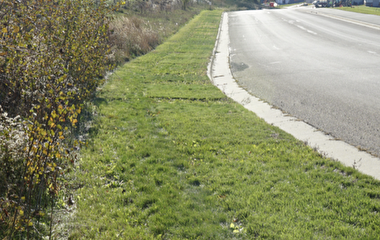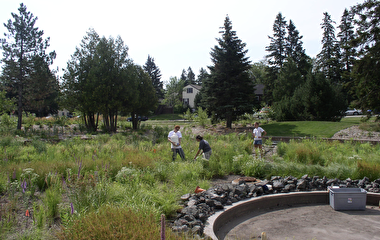Stormwater runoff from roads can contain an array of contaminants. Standard treatment methods are based on studies of urban roads with high average daily traffic (ADT) counts—tens of thousands and higher. Low-volume roads, in contrast, have rarely been studied, so little is known about the types and concentrations of contaminants in their runoff.
To fill this knowledge gap, U of M researchers collected and analyzed stormwater runoff from low-volume rural roads to determine how contaminants compared to those of high-volume roadways. The Minnesota Local Road Research Board funded the two-year study.
“If the runoff analyses differed considerably, alternative stormwater runoff treatments could be both more effective and less costly than the standard treatments for high-volume roadways,” says Professor John Gulliver of the Department of Civil, Environmental, and Geo- Engineering and the study’s principal investigator.
Whenever MnDOT and local transportation agencies add a linear acre or more of new impervious surface, they are required by the Minnesota Pollution Control Agency (MPCA) to capture and retain stormwater runoff through an approved treatment. High-volume roads frequently require expensive mitigation strategies.
For this project, low-volume roads were defined as two-lane asphalt paved rural roads with less than 1,500 ADT. Working with nine county engineers, the researchers selected 10 sampling sites in six Minnesota counties based on soil types, land uses, and other factors. The research team then developed and built “first flush” runoff sampler collectors for installation at road edges.
After 174 total rain events from June to October in 2018 and 2019, the researchers and local county agency staff retrieved the collectors and sent the water samples to a lab. Concentrations of total suspended solids, metals (such as zinc from tires and brake pads), total phosphorous, and nitrates/nitrites were measured.
The researchers found that overall, low ADT did appear to correlate with lower pollutant levels. “The adjusted concentrations of solids, phosphorous, nitrate/nitrite, copper, and zinc were found to be lower than those in high-volume road studies in the United States,” Gulliver says.
The 10 collection sites included roads near agricultural and wooded lands. All samples showed less metal contamination than high ADT urban road runoff typically contains—some to the point of metal being absent or negligible.
Runoff from low-volume roads may contain pollutants from other sources, such as galvanized farm equipment. However, models run by the researchers indicate that simpler mitigation practices, such as ditches and swales, can effectively control these pollutants and meet MPCA standards.
Based on their findings, the researchers recommend ditches with swales as an effective stormwater treatment for low-volume roads. This method is already used along many rural roads and is considerably less expensive to install and maintain than other best management practices, especially when the swale is in the right-of-way and no additional land has to be purchased.
“This study shows that low-volume rural road runoff differs substantially from high-volume urban highway runoff and can therefore be treated in ways that are more effective and at a substantially lower cost,” says John Welle, county engineer for Aitkin County. Agencies will be able to use the study’s data for their future stormwater permits.
Writer: Sophie Koch


